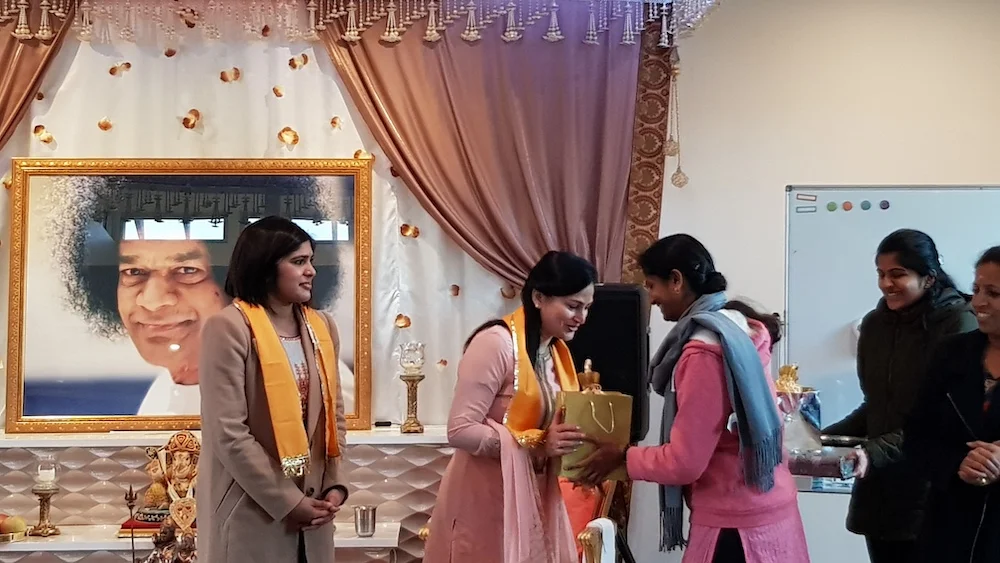 |
| The students of Sydney Sanskrit School |
How do you get children of today to learn Sanskrit? Make it fun, and that’s exactly what the organizers of the Paniniyam camp did. The camp commenced with the lighting of the lamp and the chanting of Ganesha Vandana by the students of Sydney Sanskrit School. It was followed by two interesting talks from special guests Arti Banga of Desi Australia and Liverpool councilor Charishma Kaliyanda. From then on it was four days of puzzles and quizzes, bhajans, and more to get the students excited about the ancient language.
Day 1 of the camp involved various activities like writing down the aksharas of the varnamala, ardhaksharam, gunitaksharam, samyukthaksharam and words using certain samyukthakasharam. The revision acted as a good recap for all the juniors and seniors in the camp. After a delicious lunch, the students learnt about the history of the Sanskrit script and did an activity based on the vedas. Students had to create a tree showing the different vedas and the subdivision in each veda. The seniors and juniors were very creative by making colourful leaves, fruits dangling from the tree and not wasting a tiny piece paper by inculcating the waste in the same tree. After the bhajan session and feeding of goats and geese, the students learnt about shruthi, smriti and puranas. Students learned more deeply about the number of Puranas, the names of Puranas and the shloka which is used to remember all the names of the Puranas.
The second day of the camp started with the chanting of the guruashtakam and the Maha manthra conducted by Deepak Arya. Post the completion of breakfast, students revised the 18 puranas through an activity, which included five groups of students who each write a set number of puranas from the respective shloka. After a great amount of effort put into this group activity, students had another individual activity based on guruashtkam. The activity was based on finding words in guruashtakam which had a single syllable, 2 syllables, 3 syllables, gunithaksharam and samyukthaksharam. It was highly intense but enjoyable at the same time.
The senior students of Sydney Sanskrit School had been graced with the wonderful opportunity of performing the Sanskrit National Anthem in Shri Madhir, the first temple of Australia. In the meantime, the junior students resumed their maheshwarani suthrani activities. They learnt the great significance of maheshwarani suthrani and how it emerged. Later, they prepared teaching aids to guide the younger students. Following a break, the juniors had another session where they had to write what they saw. After these intense sessions, the multi-lingual bhajan session commenced. The students then had another session where they had to find alpaprana, mahaprana and samyukthakshara shlokas. In this session, each student chanted shlokas which were part of the diverse Sanskrit literature like Bhagavath Gita, Vishnu Sahasranamam and Lalitha Sahasranamam. While the students were chanting the shlokas, Meena Arya taught the difference between shlokas, mantras, dandakas and stotras. At the end of the session, students had to identify three shlokas which had only alpaprana, mahaprana and samyukthaksharam.
 |
| Paniniyam camp started with the spiritual Mathruka meditation conducted by Meena Arya |
The third day of the Paniniyam camp started with the spiritual Mathruka meditation conducted by Meena Arya. This meditation session also included the Radha Maha Manthra Rasa, which was greatly enjoyed by the juniors. After a scrumptious breakfast, the session started with the chanting of the guruashtakam. After a half-hour of chanting the guruashtakam, students learned the techniques of a padabandha. A pada bandha is partly like a puzzle and a crossword and the students were set an activity to make a pada bandha using their own vocabulary. Following this amazing activity, students were taught an important topic of lakaaras (tenses). They were also taught to distinguish between different tenses according to the tense denoting conjugation of the verb. The topic was continued after a short lunch break where students tried to apply the tenses into simple and complex sentences. The next hour was an activity based on the six main qualities of a dog. The activity was to write the synonyms of a dog in Sanskrit write down the shloka talking about the dog’s qualities and give the meaning of each quality in English. Students enjoyed this intense but exciting activity. Day 3 of the Panniniyam camp concluded with the bhajan session and a delicious dinner.
The fourth and last day of the 22-hour intense Grammar Camp started with the Ashtaakshari Mantra, Dhyana and an auspicious yagna called Soorya Agnihotra. This yagna included the viewing of Soorya through the mudra known as Suryamudhra which helps the viewers to see the inner-most ring of the sun. This helped students energise their minds after three days of intense learning. After a delightful breakfast and some playing on the trampoline, the students revised what they had learned in the three days—the Vedas, Puranas, Upanishads, lakaaras, active voice, passive voice and much more. Following this revision, students were given a padhabandha to complete. This puzzle included clues for the word and gave the information of the number of syllables in that word. Although it was tricky to fit in all the words properly into the puzzle, the students found it really enjoying. The students chanted the guruashtakam and were presented with their certificates by Sri Subramanian Mama. The camp concluded with Vande Maatharam.
__The Indian Sun










